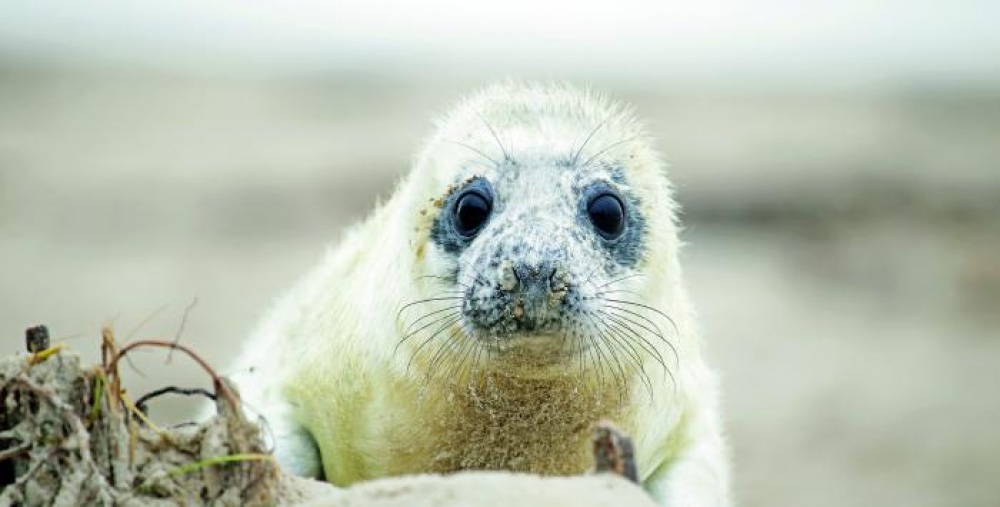Northumberland Coast Seal Pups

Rangers from the National Trust have recently revealed that 2018 was a record breeding year for the number of seal pups born off the Northumberland coast
Protected in Britain under the Conservation of Seals Act 1970, the Wildlife (Northern Ireland) Order 1985 and the Marine (Scotland) Act 2010, the curious face of an Atlantic grey seal bobbing in the waves is both a familiar and welcome sight around the North Sea coast. Global numbers are thought to be around 300,000 (according to the Seal Conservation Society), half of which live in British and Irish waters.
But while they spend most of their time out at sea feeding, grey seals will come ashore for around four months of the year to give birth – with particularly large colonies found to be breeding on sandy shores along our east coast. And for a colony that is already one of the largest in England, it has recently been reported that the breeding grey seal population on the Farne Islands has officially reached new highs – with counts by National Trust rangers working on the islands revealing that 2018 was a record year for the number of pups born in the area.
Some 2,602 youngster were counted in the last breeding season on the islands, up from 1,740 in 2014, with the increasingly healthy numbers thought to be down to a good supply of food, optimum access to (and shelter on) the islands, and a lack of predators.
Home to one of the third-largest colonies on the east coast of England, the Farne Islands have the longest history of counting the seals within any one population in the UK – the work was first started across the Farne Islands by the Natural History Society of Northumbria in 1952 (although counts on certain islands were undertaken long before this), before the National Trust took over the official monitoring of the seals in 1970. These days, a dedicated team of rangers now live and work on the Farne Islands for nine months of the year in order to prepare for, and carry out, a detailed survey of the seals during their breeding season, which runs from late September to December.
‘What we do, as a team, is spray the seal pups every four days with a special, harmless dye, which allows us to count the pups and keep track of the ones that survive and how old they get,’ explains Harriet Reid, one of the rangers working on the Farne Islands. ‘It’s important to keep track because, first of all, if we have a good number then it means that the environment around the islands is healthy, so they’re actually a good indicator of how much the surrounding ecology can support. But it’s also good to keep an eye on which islands the seals are living on, and where they’re breeding and pupping, just in terms of monitoring the topography of each of the islands.’
Born with striking, fluffy-white coats, the seal pups will remain on land until they have moulted and quadrupled their birth weight (usually around five weeks), at which point they head to the sea for the first time to learn to hunt for themselves. By using a rotation of three or four different colours of vegetable dye, each of which shows up clearly against the white of their fur, the rangers can accurately ascertain, not only the number of pups born in a single season, but also how many pups perish, meaning they can calculate the mortality rate year-on-year, to gain valuable insights into the seals’ behavioural patterns, and assess any potential risks to the population’s overall survival.
Working on the Farne Islands for nine months out of every year, life as a ranger can certainly be challenging – with the weather-dependent nature of a lot of their tasks particularly limiting at times. But, as Harriet explains, their self-contained existence opens up a greater wealth of interaction with their co-habitants on the islands – both human and otherwise.
‘It’s a really close-knit team here, so we have a lot of fun as we work,’ says Harriet. ‘Being immersed in this kind of environment every day is so exciting, and witnessing all the islands’ inhabitants throughout the breeding season is truly remarkable.
‘When we’re not spraying seal pups, we do data entry and report writing, as well as practical work around the islands – such as maintenance, repairs and readying the island each morning for the visitors’ arrival in the afternoon. Weather dictates a lot of what we do and can disrupt or delay the work, so being prepared for the unexpected and fitting everything in during the busy breeding season is pretty vital.’
Following a trial in 2017, where the Farne Islands rangers experimented with using drones to capture seal pup numbers from the air – carefully monitoring the response of the seals to the vehicles flying overhead – 2018 was the first time that the rangers officially implemented drones as they embarked upon spraying the seals, in order to check against numbers recorded on the ground to make the overall count more accurate. The drones have also allowed the rangers to see onto some of the smaller islands off the Northumberland coast, which are particularly hard for them to land on in rough seas. And the findings they have managed to obtain as a result are particularly interesting – while the majority of pups have been born on the islands of North and South Wamses in recent years, increasingly many of the seals are trying to breed on Brownsman and Staple islands, which have higher ground – providing better protection from storms and high seas.
‘It’s something that we are still researching and discussing between ourselves, but there has definitely been a noticeable movement recently of seals onto Brownsman and Staple Island from the Wamses,’ says Harriet. ‘We’re still not sure exactly why. It may be more suitable ground for breeding, it may be easier to approach for the seals, or it may just be that they are more sheltered on those islands.’
While it may not yet be certain exactly why the seals are suddenly starting to migrate, the change is obviously proving successful for the population; the 2,602 seal pups born in 2018 roughly equates to a colony size of 9,107. Numbers are based on the rangers’ estimating method of multiplying the number of youngsters by 3.5, meaning the Farne Islands’ colony accounts for approximately three percent of the world’s population alone. So when are we most likely to spot these lovable sea creatures with their young?
‘They start pupping around October time on the Farne Island,’ explains Harriet. ‘We first go out around 17th October. Then they’ll be birthing at their peak around mid-November, before quietening down towards the end of December.
‘After that most of them don’t go too far. The furthest they swim is usually 50 miles north or south of the Farnes, give or take, but they’ll mostly hang around the islands. The young pups start to get their adult coat fairly quickly – you can spot a first-year pup because they have more of a creamy coat – it’s still quite light, but not as white as the fluffy newborn pups.’
To find out more about the seal conservation work being carried out by the National Trust, visit
www.nationaltrust.org.uk/farne-islands
SET YOUR SEAL
Five fun facts about the Atlantic grey seal you may not have known
PIG IN THE MIDDLE
The grey seal’s scientific name (Halichoerus grypus) derives from the Greek meaning ‘hook-nosed sea pig’. The largest land breeding mammal in the UK, grey seals hunt alone out at sea, with their large eyes allowing them to see well in dark, murky waters. It is, however, their highly-sensitive ears that are most important when it comes to locating their prey.
ON THE SPOT
The grey seal can be distinguished from the common seal by its larger size and longer head, with a sloping 'Roman nose' profile. Looking straight on, their nostrils are parallel, rather than V-shaped as in common seals. Mainly grey in colour, the unique pattern of darker blotches and spots can be used to identify individuals.
BATED BREATH
Feeding on a wide variety of fish, squid, octopus and crustaceans (with sand eels and cod being perhaps their most important foods), grey seals are opportunistic feeders – taking whatever food source is most abundant. They spend roughly 80 percent of time below water and 20 percent on the surface breathing. Seals usually stay underwater for between four and eight minutes at a time, although the maximum time recorded is 30 minutes, and they can reach depths of 300 metres.
FAST TRACK
Grey seals are ‘capital breeders’, meaning that during their stay at a colony in the autumn both females and males fast, obtaining all of their energy requirements from their blubber. Female fasts can be over 20 days, while males can fast for over 50 days – the longer a male can stay in the colony and defend his territory, the more successful the breeding couple will be.
PUP AND AWAY
Mother and pup have a close bond at birth. For their first few weeks of life, pups are fed up to six times a day, but then are weaned in 18 days, in which time they will have quadrupled in weight. Abandoned by their mother, they then spend another 20 days or so in the colony before heading out to sea.





